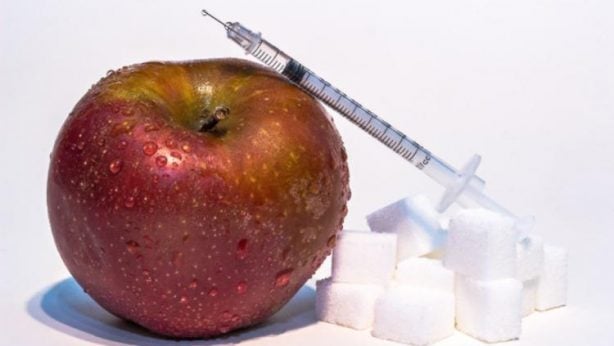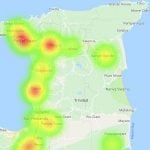Diabetes is on the rise in Trinidad & Tobago and people aren’t taking it seriously enough. This is quite worrisome, because chances are you know several people who have it.
There’s been some noise about diabetes in Trinidad & Tobago. A quick Google search presented a few news articles and a couple of organisations, but the information I found didn’t seem complete, was inaccurate or provided almost no real information about diabetes in Trinidad & Tobago.
Before I explain where I got the seemingly unrealistic number of 148822 diabetes cases in Trinidad & Tobago, I’d first like to explain what diabetes is.
Diabetes mellitus (Diabetes)
Diabetes is a chronic (persists for a long time) disease, which often weakens and may sometimes be fatal. This occurs when the human body cannot regulate its use of insulin.
Insulin is a hormone released by our pancreas (organ sitting behind the stomach), which controls the amount of glucose (sugar) in our blood.
Type 1 Diabetes
Type 1 occurs when the immune system mistakenly attacks and kills the beta cells (cells that store and release insulin) of the pancreas. This causes sugar to build up in the blood instead of being used as a source of energy.
Approximately five to ten percent of people diagnosed with diabetes have type 1. The development of type 1 typically occurs in childhood or adolescence, but can also develop in adulthood.
Type 2 Diabetes
Type 2 occurs when the body improperly uses released insulin (insulin insensitivity) or does not make enough insulin. This causes sugar build up in the blood instead of being used as a source of energy.
Approximately 90 percent of people diagnosed with diabetes have type 2. Type 2 typically develops in adults, but children can also be affected.
Diabetes: Gestational Diabetes
Gestational diabetes is a temporary condition, which occurs during pregnancy. Approximately two to four percent of all pregnancies are affected and involves an increased risk of developing diabetes both for the mother and child.
No Cure for Diabetes
Unfortunately there is no known cure for diabetes. However, it is possible for type 2 diabetes to enter into remission.
Managing Diabetes
Managing diabetes focuses on keeping blood sugar levels close to a normal range, without causing low blood sugar. This is accomplished with a healthy diet, regular exercise, weight loss, and use of certain medications.
Medication
For type 1 insulin therapy may be administered. Because enzymes in the mouth and digestive system interfere with insulin, it is recommended that insulin be injected with a syringe into a layer of body fat.
For type 2 oral medication may be administered. Some possible oral medication for type 2 includes Metformin, DiaBeta, Prandin, Avandia, Januvia, Byetta, Invokana, along with several others.
It is also possible that some people with type 2 may be treated with insulin therapy as well.
Surgery
For individuals with obesity and type 2 diabetes weight loss surgery is an option. This is only recommended if an individual cannot get their weight and blood sugar level within a normal range.
Lifestyle
Education about diabetes is important; understanding what diabetes is and how it affects the body can help individuals modify their lifestyle. Eating healthy and regular exercise are two components for taking control of diabetes.
In some cases it’s possible to for type 2 to go into remission.
[…]. When diabetes is in remission, you have no signs or symptoms of it. But your risk of relapse is higher than normal. […].
source: WebMd.com
Diabetes in Trinidad & Tobago
According to a 2017 statistics released by the worldbank, approximately 10.97% of Trinidad & Tobago’s population has either type 1 or type 2 diabetes.
The population of Trinidad & Tobago as of mid year 2017 was 1,356,633 according to the cso.gov.tt website.
10.97% of 1,356,633 people would mean that there are 148822.6 people living in Trinidad & Tobago with diabetes. However, these are just known cases, the actual number might be more.
Nutrition
Over the last several years doctors and organisations have been telling the public that diabetes is on the rise.
In September 2017, the newsday published an article titled “200,000 Trinis with diabetes, rising epidemic”. The article draws attention to several disturbing facts about the rise of diabetes.
The newsday article starts:
More than 200,000 people in Trinidad and Tobago are living with diabetes, while quarter of them don’t even know it, and about a third of children in both primary and secondary schools are juvenile diabetics or over weight says first vice president of the Diabetes association of Trinidad and Tobago, Andrew Dhanoo.
The Ministry of Health and Education is referenced for their role in helping to curb the rise of this disease:
[…] Ministry of Health and Education and Minister of Health has embarked on a positive initiative to reduce the consumption of added sugar beverages within the nation’s schools[…].
Efforts are proving futile and education is reiterated:
‘We are taking away sugar sweetened beverages from the schools but children are getting it elsewhere. They are getting it outside the schools. Education is the key and this is what the event is all about, to educate the public, the children, and the adults because education is really the key to a lifestyle change.’
Source: Newsday
Cost
In April 2017, the Trinidad Express published an article titled “Deyalsingh: $8 billion lost every year to diabetes, cancer”
The article points at how much money diabetes, hypertension (blood pressure) and cancer costs Trinidad & Tobago every year.
The cost of diabetes:
“[…] estimate were: diabetes—$3.5 billion […].”
Source: Trinidad Express
Rising food prices doesn’t make eating healthy easy, there is a proven link between poverty and diabetes. I had previously written about the agricultural average yearly prices and the historical agricultural prices, which shows an increase in food prices for a number of items in Trinidad & Tobago.
#2 Deadly Disease
Early back in March 2012, the Guardian published an article titled “Diabetes in T&T ranked No 2 killer”.
The article draws attention on a study titled “The State of Individuals with Diabetes and their Healthcare in the South-West Region of Trinidad and Tobago”.
According to Guardian the study found:
“The study found that there are shortfalls in the public health care system in the treatment of people with diabetes. Further, people with diabetes themselves have not been adequately responding to the system, it was revealed. According to the White Paper, diabetes affects an estimated 150,000 people in T&T and the numbers are growing, with 1,000 new cases every year. ‘T&T has been severely affected by the epidemic of diabetes. It is, arguably, among the countries with the greatest burden of this disease […]’
According to Guardian the study said of diabetes prevalence:
[…] the numbers affected with the disease in T&T represent an adult diabetes prevalence of around 12-13 per cent. […]
Dr Claude Khan, president of the Academy of Diabetes Clinicians of T&T, compared Trinidad & Tobago to several developed nations.
According to Guardian, Dr Khan said:
[…] this country’s figures triple those in the United Kingdom and almost double those in the United States. He said the adult diabetes prevalence in the UK is between three and four per cent and between seven and eight per cent in the United States. […]
Source: Guardian
Early Study of Diabetes
In Janurary 1968 an article titled “PREVALENCE AND NATURAL HISTORY OF DIABETES IN TRINIDAD”, published by T. Poon-King M.B., B.Sc. N.U.I., M.R.C.P.E.(PHYSICIAN), M.V. Henry M.B. Lond., M.C. Path., D.C.P.(SENIOR PATHOLOGIST) and F. Rampersad B.Sc Lond.(DEPUTY DIRECTOR,), presented a number of interesting statistics for a study on diabetes done in 1961-1962 and then followed up on five years later.
T. Poon-King and M.V. Henry worked at the San Fernando general hospital, while F. Rampersad worked at the CSO (Central Statistical Office).
According to the article summary:
A stratified random sample of the entire population of Trinidad was screened for diabetes between July, 1961, and July, 1962, and the diabetics have now been followed up for 5 years. The population sample consisted of 24,069 persons of all races and age-groups, and 23,900 (98.5%) took part in the survey. 521 (2.20%) had postprandial glycosuria, and 448 (1.89%) satisfied the criteria for diabetes. 267 (1.13%) were known diabetics, and 181 (0.76%) were unknown. Diabetes is extremely rare under 20 years of age (0.02%) but the prevalence-rate is 3.45% over the age of 20. Females show a higher prevalence (2.10%) than males (1.53%). Diabetes is more common among East Indians (2.37%) than Negroes (1.44%), and it is common in all socioeconomic groups. The urban areas show the highest prevalence of diabetes (2.67%), and the sugar-cane districts are almost as high (2.56%). Of the 448 diabetics, 133 (33.7%) gave a family history of diabetes. Overweight was more common among the female diabetics (52.90%) than the males (35.2%). 44.2% of the female diabetics had more than five live births compared with 25.2% of the non-diabetic females. There is an excess of female diabetics over the age of 40, and both overweight and multiparity of eight or more are responsible for it. The consumption of refined sugar cannot account for the high prevalence of diabetes in Trinidad nor for the racial differences between East Indians and Negroes.
Source: Lancet
I’m not sure where this article was originally published. I found this snippet on The Lancet website, which required me to purchase a PDF to gain access to the entire article.
I decided to include the article from 1968 for two reasons. One being that there are some interesting correlations between diabetes in 1968 and diabetes today. The second being the very last sentence, which reads “The consumption of refined sugar cannot account for the high prevalence of diabetes in Trinidad nor for the racial differences between East Indians and Negroes.”
Sugar Link
A little interesting don’t you think? Today added sugars are demonised for their role in diabetes, but in 1968 it didn’t seem so. Why is that? Was the sample data pool too small? Were mistakes made? Perhaps the three individuals who published the paper where in the back pockets of big sugar? Personally, i think all three scenarios are highly unlikely. My thoughts are that in a simpler time in Trinidad & Tobago there wasn’t as much processed foods as there are today and the average person worked harder and longer. I’m not a historian or a scientist, so of course I could be wrong.
Conclusion
Education is the only way to prevent this chronic disease. However, there are two problems with this in which I face regularly.
The first reason? People won’t listen. When it comes to personal health, everyone knows that proper nutrition and regular exercise is important, yet many individuals find it extremely difficult. Contributing factors are lack of motivation, busy lifestyle, belief that medication is the way, health problems, and fatigue. Unfortunately I haven’t found the answer to this.
The second reason is misinformation by researchers or big companies. This usually involves picking a source of data and presenting it in a way that is advantageous to the presenter, or simply not being objective of scientific research. The answer to this one is simple, find a trusted source of information; a reputable news outlet, government website or an association advocating for the betterment of individuals.
Diabetes is real and unless taken seriously, it will eventually prevent individuals from leading a normal life. It should go without saying that “Prevention is better than cure.”



